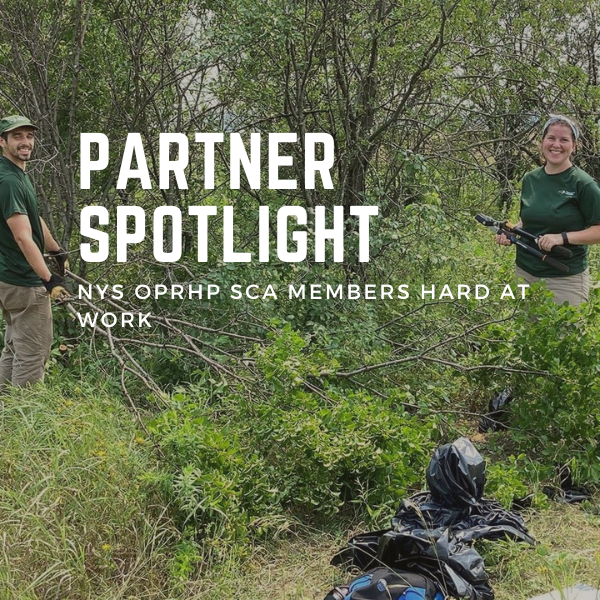This article was featured in the 2022 Summer Newsletter by Maria Cipullo-Regional Trails Coordinator/SCA Supervisor.
The NYS Office of Parks, Recreation and Historic Preservation (OPRHP) in the Thousand Islands Region has continued working “to be responsible stewards of our valuable natural, historic and cultural resources,” as written into our mission statement. Since 2017, our OPRHP region has hosted the Student Conservation Association (SCA) to ensure that this work does not go undone. SCA is an internship/career training program designed to expose its members to a wide variety of projects, techniques, and career specialties. These members work hand-in-hand with OPRHP staff on projects throughout the entire region, as well as collaborating with other local non-profits as needed for conservation efforts. Small projects we have helped with include releasing biocontrol insects, removing water chestnut, oriental bittersweet, water-milfoil, and yellow iris, as well as replanting the native Lake Ontario dune grass.
There has been an effort to map invasives species across all 28 of our State Parks, with priority work sites that we return to year after year. Common and glossy buckthorns are a species many are familiar with for their incessant bushy growth, painful thorn pricks, and non-nutritious berries. Sackets Harbor Battlefield State Historic Site – a key player in the War of 1812 – has been riddled with buckthorn for decades. Our crew has worked to control this by cutting shrubs smaller than ~3 inches in diameter and securing a thick, black plastic bag over each stump which smothers the plant and prevents re-sprouting, effectively killing the root system without any herbicide in as little as 1-2 years. In other zones of the Battlefield, mature, tree sized buckthorn is cut to be flush with the ground so that a stump grinder can come through and break up these massive trunks and root systems. This year there has been incredible support from the maintenance staff who have bolstered our efforts by acquiring a brush hog which can continue to cut back any juvenile growth to allow for native grasses and open meadow species to come back. Dense monocultures of buckthorn have been completely cut out from 0.5 acres of the western battlefield, and sporadic shrubby buckthorn has been removed from 0.75 acres within the central battlefield.
Mid-to-late June is the best time to find both pale and black swallow-wort in its mature growth state, making for easy identification. While many of our Eastern Lake Ontario parks have large well-established monocultures of swallow-worts, our St. Lawrence River parks still only have isolated populations. Our crew has worked diligently on Wellesley Island State Park to control the pale variety close to the Minna Anthony Common Nature Center – a stubborn patch we have returned to year after year – with efforts finally showing success. After 5 years of consistent manual removal this patch has gone from a main area of 16,000 sq-ft to just 4,000 sq-ft. Last year our staff found a new population of the black variety off of River Trail near South Bay. As a rapid response reaction, our crew spent time removing from this area as well. This proved successful as when we returned this year what was an estimated original population of 500 plants was now down to about 200 plants, which we were able to completely remove. It is always exciting to see hard work starting to pay off – carefully digging out densely tangled plants to the root ball and hauling them away in thick black trash bags during peak daylight hours in early summer is no small feat.



All photos were provided by Maria Cipullo with NYSOPRHP and include SCA Members: Nicholas Sawyer, Caroline Leeper, Omar Elsheikh, Max Bernhofer, PJ Lombardi, Sam Moy, CJ Legg, and Celeste Oppito.


